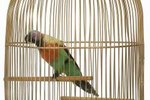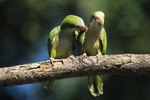
Some birds show dramatic differences from one gender to the other, in behavior, song and, most of all, plumage. Doves, however, are not among these birds. Male and female ringneck doves, the species most often found in captivity, look identical. Other species vary. Your vet can confirm matters with a DNA test. In the meantime, observe your bird closely.
Appearance
Adult ringneck doves show no external physical differences between genders. The diamond dove (Geopelia cuneata) -- the other species often found in the pet trade -- sometimes show sexual dimorphism, depending on the variety. Females of the wild form of diamond doves have more brown in their plumage and less-obvious ceres, the fleshy bit around the eyes. Other, more exotic species of dove may show obvious gender differences once the birds are grown. As with many other birds, these differences usually involve more vividly or differently colored plumage in the males.
Behavior
The typical bowing and cooing displayed by pigeons and doves comes mostly, although not entirely, from the males -- it's a courtship display. Females sometimes exhibit these behaviors, but not nearly so often. If you have two or more doves of any species, look for the ones putting on a display, who are probably the males. Another means is to put a mirror in the cage and watch how the birds respond. A male might decide to court his reflection; a female probably won’t. Aside from this, male and female doves behave in similar ways; usually both are equally involved in caring for their young.
Pairing
Because they are social creatures who develop strong pair bonds, captive doves should live in pairs or small flocks. Two doves of the same gender could bond, but male and female pairs usually become the closest. If you have adopted a bonded pair from an animal sanctuary, it doesn’t particularly matter what gender they are, but if you are choosing a couple of doves from a breeder, find out their genders beforehand.
Considerations
Two males together or too many males and not enough females in a group can lead to squabbling. Aim for either a 1-to-1ratio or slightly more males than females in a group. The birds will almost certainly try to breed, but don’t let them unless you have arranged homes for all the offspring or have the space to accommodate them yourself. Not providing a suitable nesting site prevents doves breeding, as does, as a last resort, removing eggs.
References
Photo Credits
-
David De Lossy/Photodisc/Getty Images
Writer Bio
Judith Willson has been writing since 2009, specializing in environmental and scientific topics. She has written content for school websites and worked for a Glasgow newspaper. Willson has a Master of Arts in English from the University of Aberdeen, Scotland.



